Latin America Space Roundup: 25 April to 8 May 2025
A summary of all the space news in Latin America over the past two weeks, brought to you by AzurX
The following are the major space developments in the Latin American region tracked by Latin America Space Monitor over the past two weeks:
China’s Latin America Space Ambitions
China to Make Big Space Diplomacy Push in Latin America as the U.S. Stays at Home
China is poised to deepen its multilateral engagement with Latin America through a series of high-level forums, including the upcoming China-CELAC Ministerial Forum, the OAS General Assembly, and the BRICS Summit in Brazil, amid rising regional discontent with U.S. tariff policies. Space and satellite collaboration are expected to feature prominently in China’s strategic roadmap for the region, reflecting its expanding influence via initiatives such as the CBERS satellite program with Brazil, lunar cooperation offers under the International Lunar Research Station (ILRS), and its operation of dual-use observatories in Argentina and Chile. Beijing is also positioning itself as a partner of choice for Latin American governments seeking infrastructure investment, space capacity building, and alternatives to U.S.-dominated digital and financial architectures. As Washington scales back diplomatic and aid programs, China’s soft power gains—especially in space cooperation—signal a broader shift toward a multipolar order where Beijing increasingly defines the rules and institutions of regional engagement.
Peru is Going to the Moon With China’s Chang’e-8 Lunar Mission
Peru has secured a role in China’s upcoming Chang’e-8 lunar mission through a joint payload selected for deployment in 2028 or 2029—a radio astronomy array developed in collaboration between the South African Radio Astronomy Observatory and the National Commission for Aerospace Research and Development (CONIDA). This marks a significant milestone in Peru’s growing engagement with the China-led International Lunar Research Station (ILRS) initiative, which it supports as a member of the Asia-Pacific Space Cooperation Organization (APSCO). The selection underscores Peru’s commitment to advancing its space science capabilities and positions it within a global coalition pursuing lunar exploration independent of U.S.-led frameworks like the Artemis Accords. As China expands its space diplomacy, Peru’s inclusion signals an emerging role for Latin American countries in the evolving multipolar lunar order.
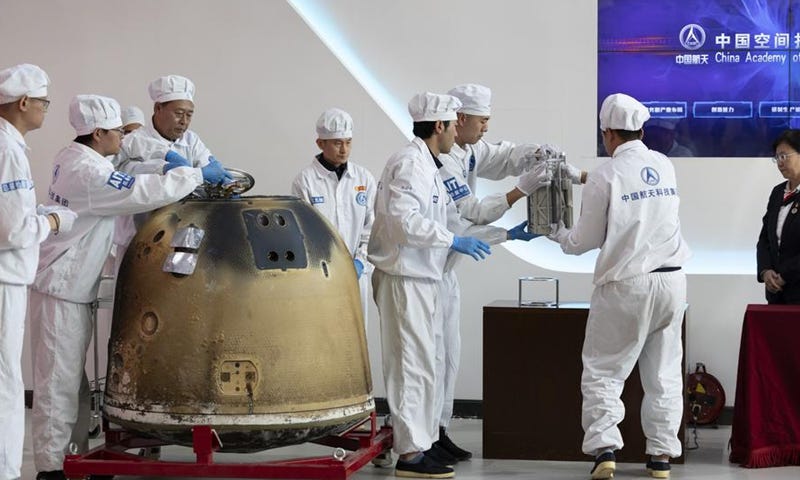
Bolivia, Nicaragua, and Venezuela Join China’s ILRS Moon Consortium
At the recent BRICS space agency meeting in Brazil, Roscosmos chief Dmitry Bakanov announced that thirteen countries—including Bolivia, Nicaragua, and Venezuela—have formally joined China’s International Lunar Research Station (ILRS) initiative, signaling expanding South-South cooperation in space. The inclusion of these Latin American countries underscores Beijing’s strategy to build a multipolar space alliance beyond traditional Western partnerships. The ILRS aims to develop joint lunar infrastructure and scientific missions, offering countries like Bolivia and Venezuela a platform to participate in advanced space activities despite limited domestic capabilities.
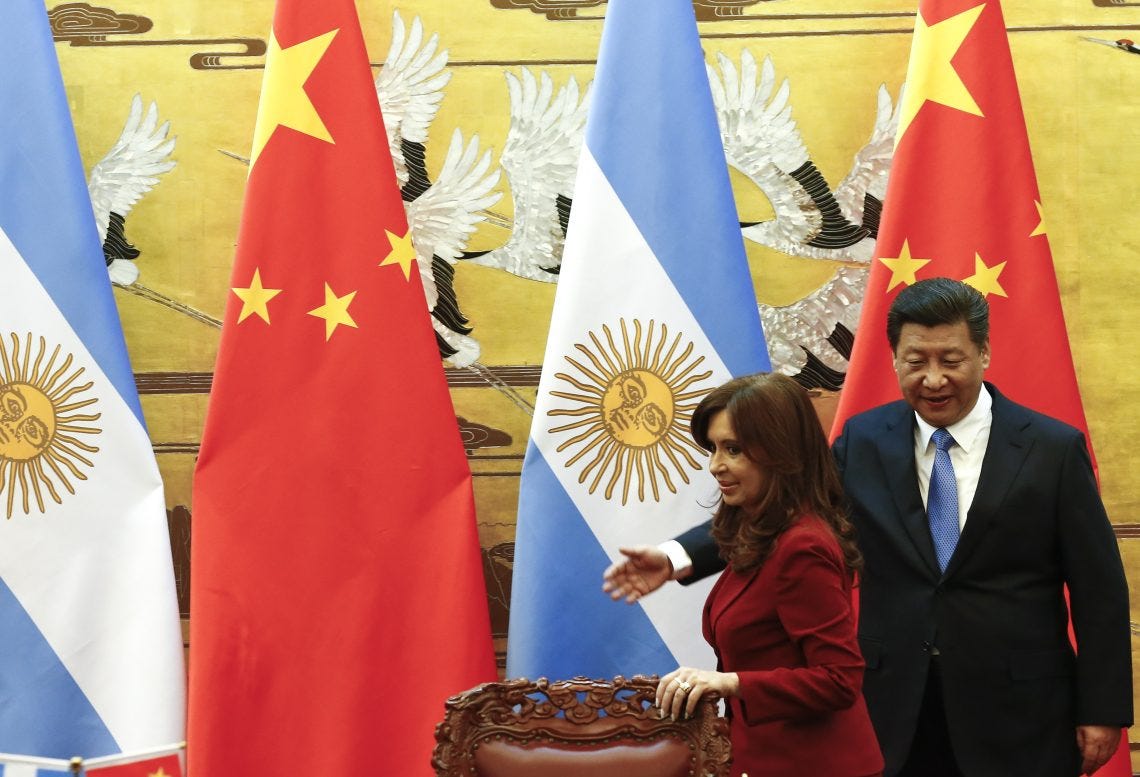
Argentina Plays Vital Role in China’s Lunar Exploration According to Chinese Official
At China’s recent Space Day celebrations in Shanghai, Wu Weiren, chief designer of China's lunar exploration program, confirmed Argentina’s participation in the China-led International Lunar Research Station (ILRS), highlighting growing space cooperation between the two countries. Argentina is involved in ground-based technical collaboration, including tracking and communications support, reinforcing its strategic role in China's fourth phase of lunar exploration. With 17 countries and over 50 research institutions now engaged in the ILRS, China's emphasis on joint lunar missions, scientific instrumentation, and data sharing opens new pathways for Argentina to deepen its presence in international space science, particularly in collaborative lunar research and technology development.
U.S.-China Tensions Continue to Simmer Over Observatory in Chile
China has called on Chile to approve the construction of a Chinese-funded astronomical observatory in the Atacama Desert, accusing the United States of obstructing the project over alleged military surveillance concerns. Chinese Ambassador Niu Qingbao criticized U.S. “interference” and urged Chile to assert its sovereignty, as the halted project—initiated in 2016 through an agreement with Universidad Católica del Norte—remains under review by Chilean authorities. The dispute underscores Chile’s strategic dilemma as it navigates between major trade and technology partners: China, which accounts for 40% of its exports, and the U.S., which remains wary of China's expanding presence in Latin America’s critical space infrastructure. With 70% of global space observation capacity hosted in Chile due to its ideal conditions, the outcome of this dispute could set important precedents for foreign-led space ventures in the region.
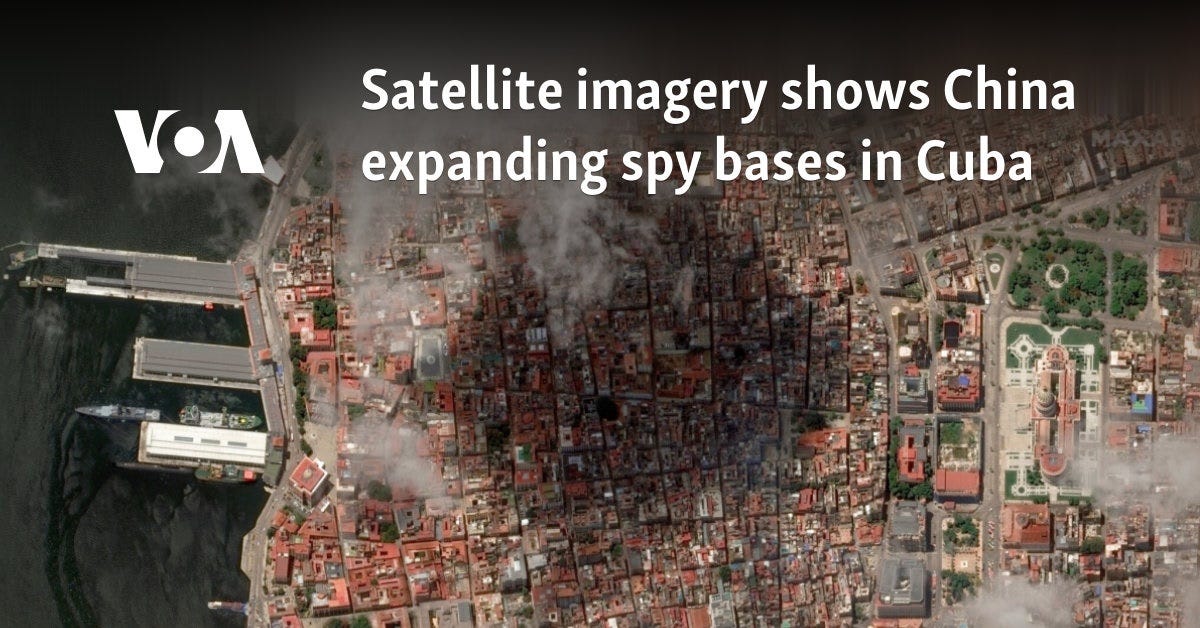
Concerns Grow That China Uses Cuba to Spy on U.S. Space Activities
Testifying before the U.S. House Homeland Security Subcommittee, Ryan Berg of think tank CSIS outlined growing concerns over China’s expanding signals intelligence (SIGINT) presence in Cuba, which poses a serious threat to U.S. national security—particularly in the space sector. Using satellite imagery, CSIS has confirmed four key Chinese-operated or supported SIGINT sites on the island, including Bejucal, near Havana, which has shown recent construction of a Circular Disposed Antenna Array (CDAA). These facilities, positioned just 93 miles from Florida, place U.S. military assets—including those at Cape Canaveral and other space infrastructure—within potential surveillance range. Berg emphasized that China’s partnership with Cuba leverages the island’s strategic location and outdated Soviet infrastructure to conduct wide-ranging espionage, possibly including commercial space activities from firms like SpaceX. He warned of the implications for U.S. and regional allies’ civilian and military space operations, and recommended targeted declassification, regional diplomacy, and cybersecurity support to counter China's deepening space-intelligence footprint in the Western Hemisphere.
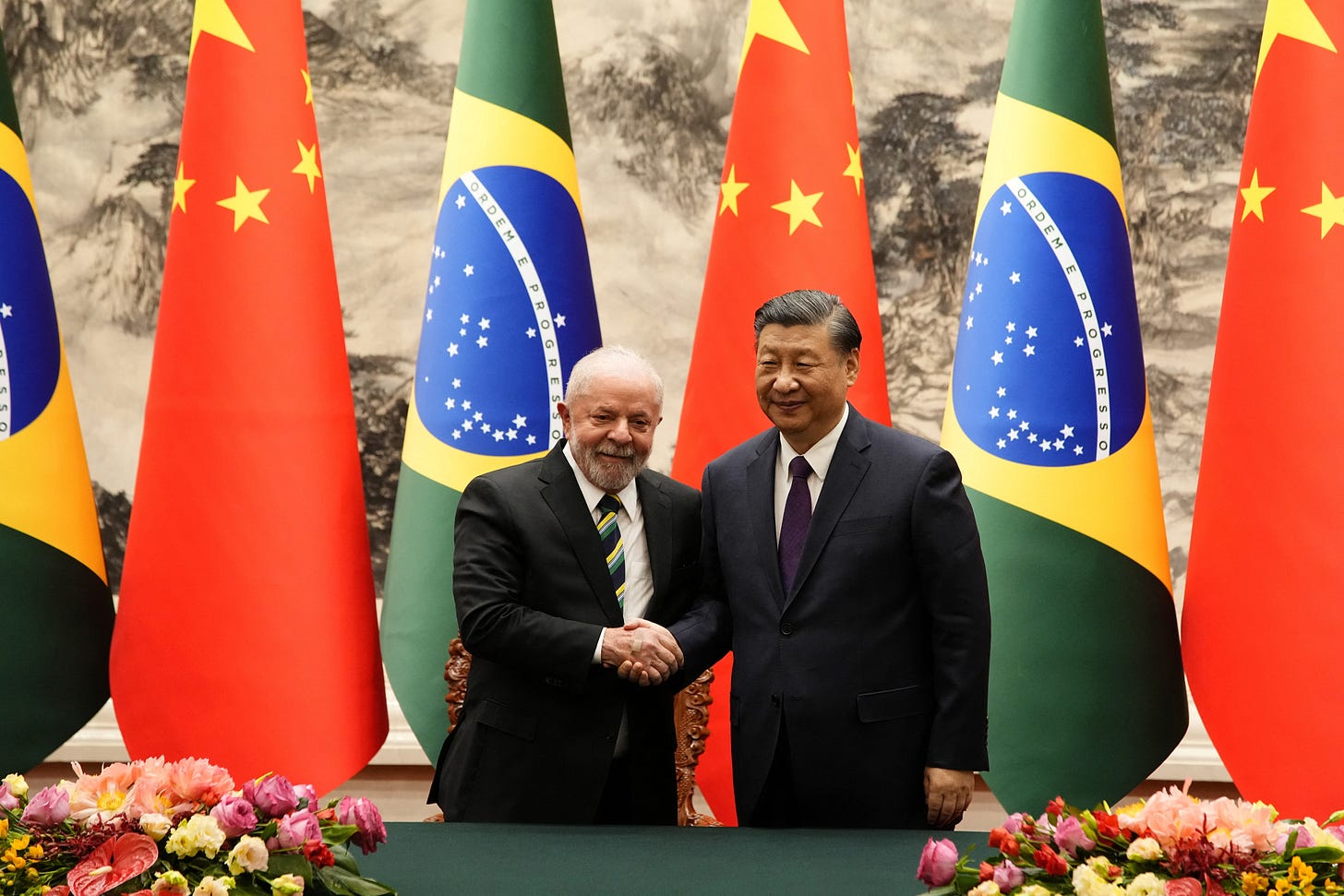
China and Brazil Space Cooperation is Comprehensive
China and Brazil’s four-decade space partnership exemplifies a successful South-South collaboration in high technology, marked by the co-development and launch of six CBERS Earth observation satellites and the construction of the BINGO radio telescope in northeastern Brazil. The CBERS program, notable for its free distribution of satellite imagery, underpins Brazil’s PRODES and DETER systems for tracking deforestation and environmental degradation, while fostering technological autonomy in both countries. Now expanding into deep space observation, the partnership reflects a broader commitment to using space-based systems not only for global scientific advancement but also for domestic environmental management and regional innovation-led development.
China-Latin America Science Day Drives Space Cooperation With Brazil, Bolivia, and Peru
At the recent China-Latin America Science Day, held by China’s Ministry of Science and Technology, over 20 Latin American and Caribbean countries—including Peru—joined Chinese officials and scientific institutions to deepen cooperation in high-tech sectors, with particular emphasis on space and satellite applications. Highlighted examples included the China-Brazil Earth Resources Satellite (CBERS) program, which supports Amazon rainforest monitoring, and China’s satellite partnership with Bolivia, which enables remote education and healthcare. Peru’s participation reflects its growing interest in leveraging China’s advanced capabilities in satellite technology, digital infrastructure, and aerospace under the broader China-CELAC Forum framework. With new forums focused on aerospace and digital innovation, and amid a geopolitical backdrop of resistance to technological monopolies, China-Latin America cooperation is emerging as a counterbalance to Western-dominated space partnerships, fostering multipolarity in the global satellite and space economy.
Brazil Space Developments
Brazil Hosts BRICS Space Agency Leaders Summit
From 27 to 29 April 2025, Brazil hosted a pivotal meeting of BRICS space agency leaders, with heads of agencies from Russia, Brazil, India, China, South Africa, Egypt, and the UAE participating. The agenda prioritized leveraging satellite-based remote sensing for climate resilience, disaster response, and food security, in anticipation of the 30th UN Climate Change Conference (COP30). Key discussions also addressed technological asymmetries among BRICS members, proposing joint R&D and educational initiatives to bridge gaps and strengthen internal cohesion.
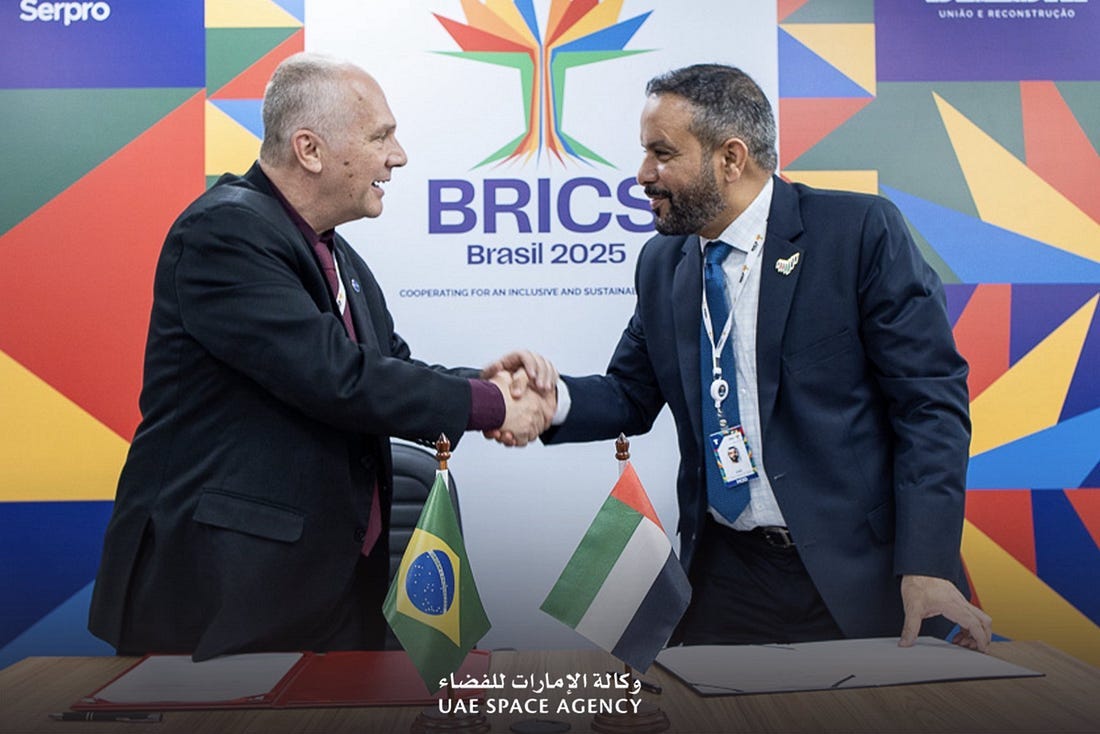
Brazil Signs MoU With UAE Space Agency on Sidelines of BRICS Space Summit
At the BRICS Heads of Space Agencies meeting in Brazil, the UAE Space Agency and the Brazilian Space Agency signed a Memorandum of Understanding to advance bilateral cooperation through the exchange of satellite imagery and geospatial data across key sectors such as water management, disaster monitoring, environmental assessment, and resource exploration. The agreement underscores a shared commitment to leveraging space technologies for sustainable development and socioeconomic impact, aligning with the UN Sustainable Development Goals.
Spain’s Hispasat Offers Satellite Video in Latin America, Starting in Brazil
Spain’s Hispasat is reinforcing its strategic focus on satellite-powered video and connectivity services across Latin America, highlighting its Direct-to-Home (DTH) television operations and the launch of its white-label OTT platform, Wave OTT Plus, initially targeting Brazil. Designed for local operators, the OTT service aims to offer monetizable, multi-content solutions adaptable to diverse network environments. Beyond video, Hispasat is advancing connectivity projects in partnership with telecom providers and regional governments—such as infrastructure initiatives underway in Peru—and is actively pursuing technological convergence to enable fiber-based operators to integrate OTT and video services, positioning itself as a key enabler in the region’s digital transformation.
Think-Tank Report Urges U.S. to Counter Growing Chinese SATCOM Use in Brazil
A decade into China’s Digital Silk Road (DSR), Brazil has emerged as a key battleground for global influence in space and digital infrastructure, according to a new report from U.S. think-tank the Center for a New American Security (CNAS). China’s deepening technological footprint—spanning smart cities, telecommunications, and satellite-related services—has given it a strategic edge, reinforced by state-backed investment and diplomacy. While the U.S. still leads in cloud computing, AI, and low-Earth orbit (LEO) satellite services, its political engagement has lagged. The CNAS report urges the U.S. to strengthen its position by accelerating the deployment of LEO satellites from firms like Starlink and Kuiper to expand rural connectivity, offering Brazil trusted alternatives to Chinese technology. With Brazil advancing sovereign digital governance and prioritizing secure infrastructure, U.S. satellite solutions aligned with local priorities could not only counterbalance Chinese influence but also anchor democratic norms and American tech leadership across Latin America.
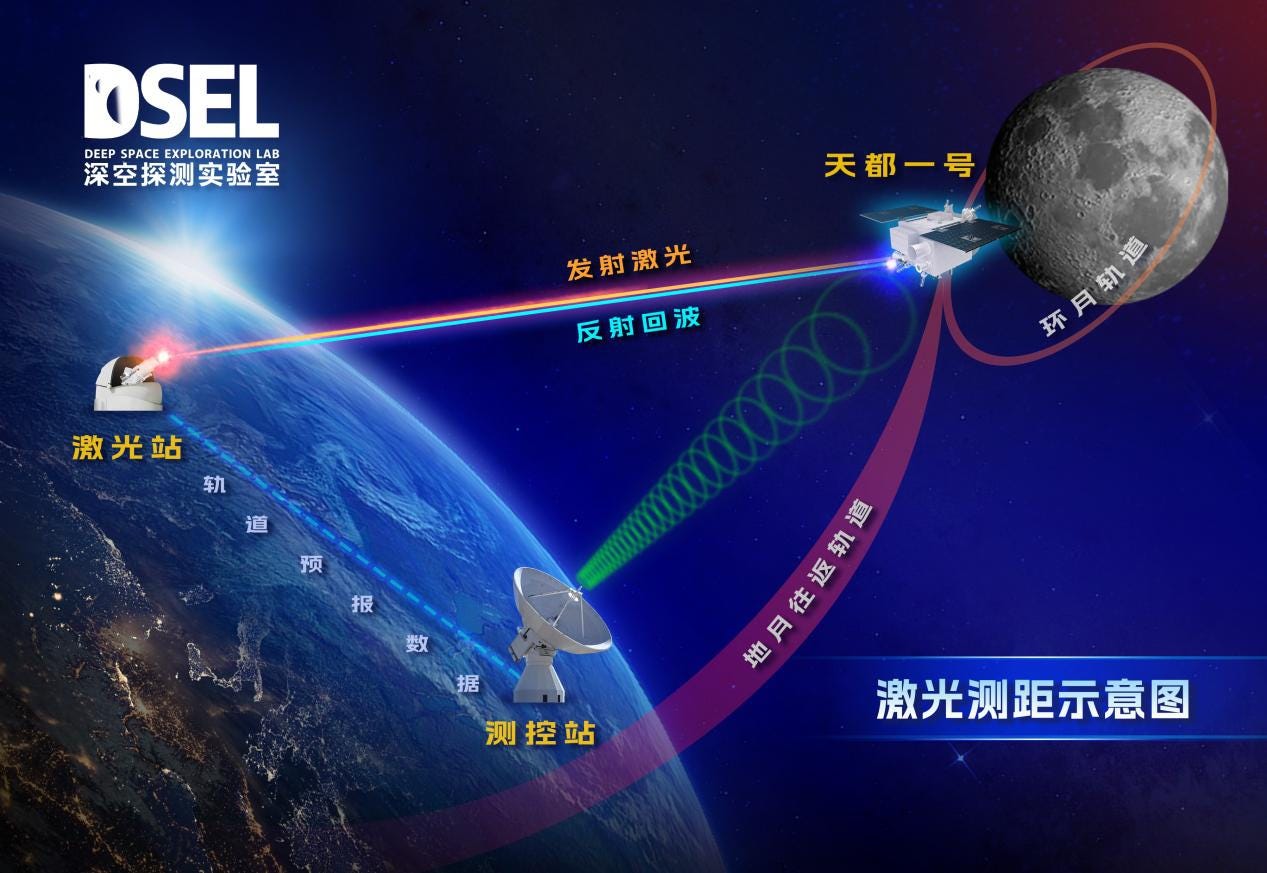
Chile Space News
Chile Hosts Inaugural Workshop of Resources Lunaris 2025 Circular Space Economy Initiative
The inaugural Resources Lunaris 2025 workshop, held in Santiago, Chile, from 21 to 22 April 2025, launched an ambitious initiative to establish a southern hemisphere space agency and advance sustainable space resource technologies. Framing the American Continental Divide—and Chile in particular—as a strategic geophysical and technological hub, the workshop promoted a fusion of ancestral ecological wisdom and cutting-edge space innovation. With participation from countries including Brazil, Australia, South Korea, and the U.S., the event positioned Chile’s emerging network of space centers and planned longitudinal orbital satellites as central to shaping an interdependent, environmentally grounded space economy. The Artemis Accords were emphasized as a collaborative foundation, guiding the transition toward a new quantum space era rooted in circular, exoplanetary-driven development.
Starlink to Rollout Direct-to-Cell SATCOM Technology in Chile
SpaceX has announced the rollout of its Starlink Direct-to-Cell (D2C) technology in Chile and across South America, marking a significant milestone in satellite-enabled mobile connectivity. Partnering with Entel Chile, the country’s largest telecommunications provider, Starlink will enable users to send messages, make calls, and access the internet without relying on traditional cell towers—expanding coverage to remote and underserved areas. The move follows the latest Falcon 9 launch of 28 Starlink satellites, further reinforcing the company's ambition to deliver seamless global internet access and position satellite-mobile integration as a cornerstone of future telecommunications infrastructure.
South Korea’s Hanwha Offers SAR Satellites to Chile’s Air Force
At the Korea Defense Day 2025 exhibition in Chile, Hanwha Systems spotlighted its growing role in space technologies by presenting small synthetic aperture radar (SAR) systems, satellite platforms, and satellite imagery analysis solutions, aligning with the Chilean Air Force’s national space program (SNSAT). This strategic focus on space and satellite capabilities complements broader efforts by Hanwha Group’s defense units to expand in Latin America, positioning Chile as a regional hub for defense and space collaboration. The event, organized by KOTRA and the Korean Embassy in Chile, drew senior Chilean defense officials and reinforced Hanwha’s commitment to integrated space-defense partnerships in the region.
Costa Rica Space Developments
Rivada Space Networks to Offer Outernet LEO SATCOM Services in Costa Rica
Rivada Space Networks has secured market access to launch its planned Outernet services in Costa Rica, marking a strategic milestone as the company expands its footprint in Latin America. Costa Rica joins a growing list of 33 countries—including several developing economies—supporting Rivada’s proposed 600-satellite LEO constellation, which aims to deliver secure, laser-connected communications for enterprise and government users. While satellite launches are delayed until 2026 with commercial service expected by late 2027, Rivada reports that signed agreements across its global rollout now exceed $16 billion in value, reflecting strong international regulatory and investor confidence.
Cuba Space News
Cuba Intensifies Efforts to Block Starlink Amidst Increasing Cases of Smuggling
Authorities in Cuba have intensified efforts to block unauthorized satellite internet access, intercepting three Starlink terminals hidden inside televisions shipped from the U.S. to Holguín province. The seizure highlights Havana’s crackdown on Elon Musk’s SpaceX satellite system, which enables high-speed, uncensored connectivity independent of the state telecom monopoly ETECSA. While Cuban officials cite “radio spectrum control” as justification, the regime’s true concern lies in losing information sovereignty. Starlink equipment is banned in Cuba, yet its demand persists on the island’s black market, where prices exceed $1,300. The government has escalated customs inspections and legal threats, underscoring the geopolitical and technological stakes of bypassing centralized internet control.
French Guiana Space Developments
ESA’s Biomass Successfully Launched From European Spaceport in French Guiana
The successful 29 April 2025 launch of the European Space Agency’s (ESA) Biomass satellite aboard a Vega-C rocket from the European Spaceport in Kourou, French Guiana, marked a significant step in restoring European space launch sovereignty following recent setbacks. Operated by Arianespace, the mission demonstrated the renewed reliability of Vega-C after its December 2024 return to flight and symbolized Europe's reduced dependence on external launch providers. Kourou remains pivotal to Europe's independent access to space, particularly as the continent ramps up both Vega-C and Ariane-6 operations. The Biomass satellite, built by Airbus Defence and Space and launched from Kourou’s equatorial site, will provide critical P-band radar data on global forest carbon stocks, reinforcing the strategic importance of French Guiana in supporting both Earth observation and Europe’s geopolitical space ambitions.
French Guiana Launch Site Eyed by U.S. Space Force for International Launch Partnership
The U.S. Space Force is exploring potential international partnerships to diversify and bolster its national security launch capabilities, with early discussions underway with countries that possess established or emerging launch infrastructure—including France, which operates the Guiana Space Center in French Guiana through Arianespace and CNES. Brig. Gen. Kristin Panzenhagen emphasized that while current U.S. launch capacity meets operational needs, enhancing access through allied facilities like French Guiana could increase strategic resiliency. The Guiana Space Center, already integral to European and commercial space operations, is being considered as a potential future asset in expanding interoperable launch options under the Space Force’s evolving assured access to space strategy.
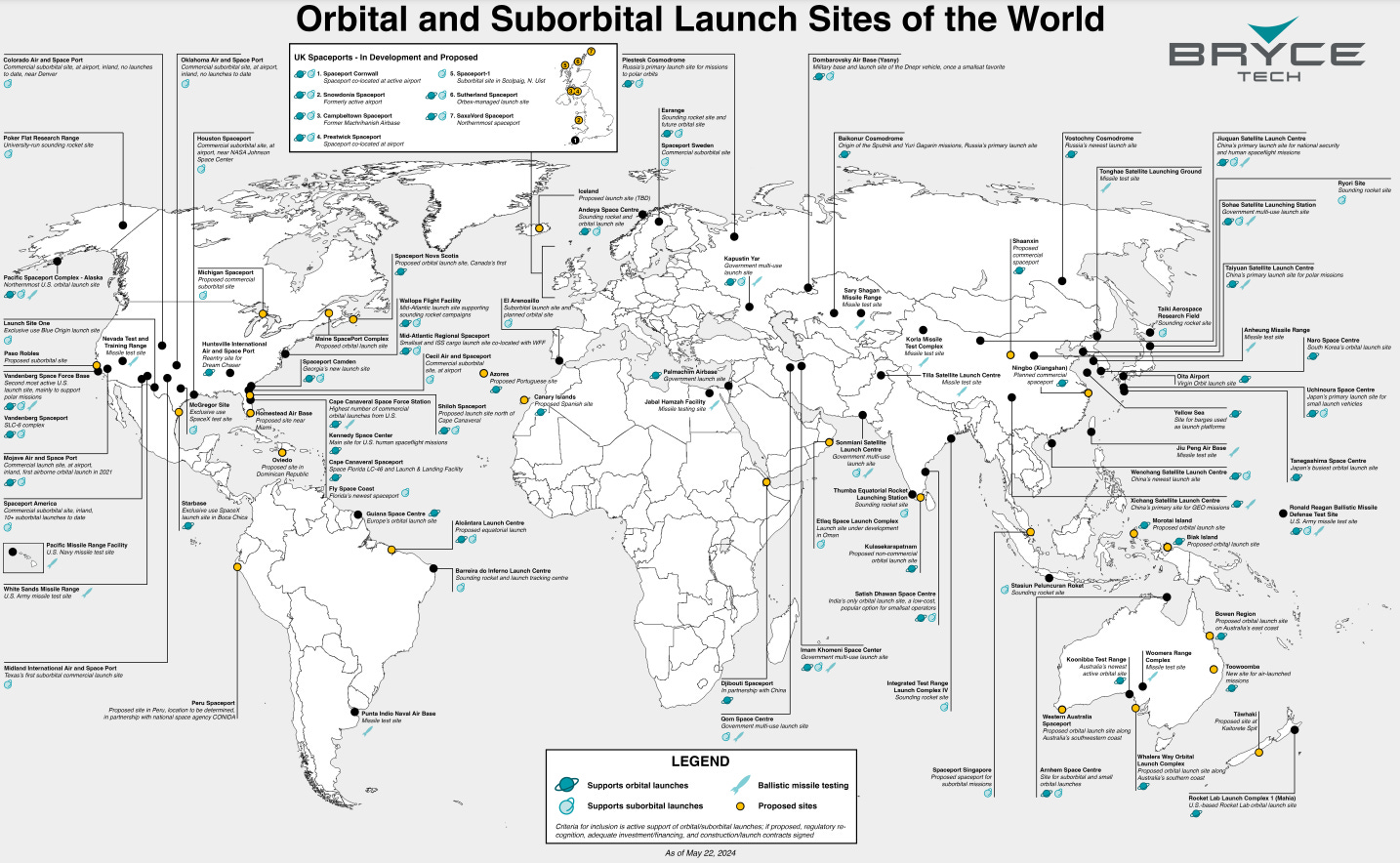
Mexico Space News
Mexico to Launch National Telecommunications Satellite to Boost Remote Connectivity
At FAMEX 2025, Mexico’s Agency for Digital Transformation and Telecommunications (ATDT) unveiled plans to launch a new national telecommunications satellite, aiming to expand satellite capacity twentyfold to provide connectivity to over 3,000 remote communities lacking public infrastructure. The initiative will also support strategic government services, including the Mayan Train and the Welfare Bank, and will be paired with a new image processing lab to operationalize satellite telemetry. ATDT’s Satellite Director, Brenda Escobar Méndez, emphasized international collaboration and practical applications of space data, while astronaut Katya Echazarreta underscored the urgency of building domestic talent and technology to ensure Mexican leadership in the space sector.
Peru Space Developments
Korea Aerospace Industries Offer SAR Satellites to Peru, Other Latin American Countries
At SITDEF 2025 in Lima, Peru, South Korea’s Korea Aerospace Industries (KAI) showcased a comprehensive portfolio—including synthetic aperture radar (SAR) satellites—underscoring its intent to expand its presence in Latin America, with Peru as a strategic entry point. In addition to fighter jets and drones, KAI is promoting satellite technologies as part of its integrated defense offerings. The company emphasized its ongoing cooperation with Peru, which already operates KT-1P aircraft, and is exploring future procurement of the FA-50 and potentially SAR satellite systems. MOUs for joint production of aircraft components reflect deepening industrial ties, while KAI positions its satellite capabilities as part of a broader push to provide advanced aerospace solutions across the region.
Venezuela Space News
Venezuela Announces Operations of Russian GLONASS Satellite Navigation Ground Station
Venezuela has officially begun operations of a Russian GLONASS satellite navigation ground station, marking a significant step in deepening space and technology ties with Moscow while boosting national geolocation capabilities. Announced by President Nicolás Maduro, the SS1-S tracking station will support land, maritime, and air navigation, precision agriculture, infrastructure monitoring, and scientific research. Originally agreed upon with Roscosmos in 2022, the station enhances GLONASS coverage in the Western Hemisphere and contributes to Russia’s global positioning system network—offering Venezuela a strategic alternative to U.S. GPS, Europe’s Galileo, and China’s BeiDou.
Other Regional Space Developments
Brazil, Chile, Colombia, and Peru Participate in U.S. Space Command’s Global Sentinel 2025 Exercise
At Global Sentinel 2025, held at Vandenberg Space Force Base, the United States Space Command convened nearly 30 countries, including Brazil, Chile, Colombia, and Peru, to advance international space security cooperation. The two-week exercise focuses on space situational awareness, domain coordination, and responsible behavior in orbit, utilizing a customized simulation platform and real-world modeling. Brazil, Colombia, and Peru returned as key Latin American participants, while Chile joined for the first time—signaling the region’s growing role in global space operations. The inclusion of these countries underscores expanding regional collaboration in space security and reinforces their strategic commitment to multilateral space governance and operational readiness.
Intelsat and AXESS Networks Partner to Deliver Satellite Communications Across the Americas
Intelsat and AXESS Networks, a Hispasat company, have deepened their strategic partnership to deliver enhanced satellite communication services across the Americas by jointly leveraging their combined satellite and ground infrastructure. The renewed agreement enables multi-satellite, high-quality connectivity tailored to client needs, expanding reliable coverage and reinforcing both companies’ commitment to delivering seamless, customer-focused solutions. This collaboration reflects growing industry trends toward integrated regional capabilities and service reliability through strategic alliances.
Upcoming Event
Colombian Space Agency to Host Novaspace’s LATSAT 2025 Space Conference in November 2025
LATSAT 2025, Latin America’s leading space conference, will convene in Bogotá, Colombia on 19 to 20 November 2025, uniting over 300 senior stakeholders from across the satellite communications, Earth observation, and connectivity sectors. Co-hosted by Novaspace and the Colombian Space Agency, the event aims to catalyze regional industry growth through high-level discussions, policy dialogues, and strategic networking. Positioned as a platform for business development and public-private collaboration, LATSAT underscores Latin America’s rising influence in the global space ecosystem and Colombia’s ambition to be a key innovation hub for the region’s space future.
Be sure to catch up with space activities in the region in the next edition of Latin America Space Monitor’s space roundup!













